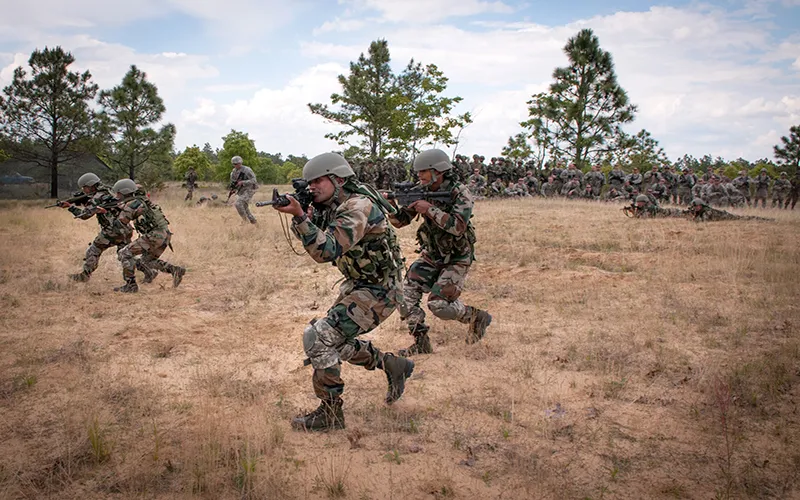The MALABAR 2015 joint Naval exercises between India and US have caught the media attention in a big way. The implications of Japan joining this year while Australia gets a separate exercise (AUSINDEX), has commentators of all hues analysing in earnest. It's almost raining joint military exercises, with the Indian military finding it difficult to accede to the numerous demands of countries to have bilateral or multilateral exercises. Undoubtedly, such exercises herald the coming together of militaries and ostensibly are the most visible and potent instrumentalities for building interoperability and in some cases reducing national mistrust. However, do these hold good for India and are they really as beneficial as they are made out to be? Since huge amounts of public money are spent on these events, an unbiased cost-benefit analysis to determine their true worth is necessary.
Undeniably, it has been quite a strategic transition for India to shed its extreme isolationistic military profile that was prominent during the Cold War era to the current period when frequent joint military exercises is more the norm signifying a 'have arrived' message.
Joint exercises can be of a simple type, involving (in the Navy for example) mere passing of warships or ship manoeuvres, practice gun-fire from close or medium range weapons or simple SAR (Search and Rescue) exercises. Others exercises are slightly complex, involving some basic tactics. Finally, there are complex exercises which involve combined tactics of surface warships, aircraft and submarines, and are scenario-based.
Subterraneously, exercises are always used to assess the participating forces even though they may be from friendly countries. The efficacy of their platforms/ weapons and their effective ranges, signatures etc are all analysed and recorded. The professionalism of the personnel is of primary importance since any equipment is only as good as the human behind it. Thus, the response timing, thinking process and work ethos are also noted for developing better interoperability. Additionally, it is necessary to decode the nuances of the tactics in use, while simultaneously guarding against revealing too much of one's own. Thus, exercises have implications at various levels and signify different meanings to different people. For a security strategist, they indicate an evolving strategic congruence or in some cases an instrument to reduce mistrust, as a confidence-building measure between adversarial powers (like India and China). To an arms manufacturer, exercises are a live advertisement of the technology on offer, while to a military person it signifies an opportunity to display professional prowess, capability, and probably on a personal level manage a trip abroad for discussions and planning.
Overall, exercises between Armies are mostly beneficial for India since the level of participation rarely exceeds that of a brigade, more often a battalion, which means that the tactics involved are low with lesser concern of revealing higher tactics inadvertently during exercises. Given our Army's experience in counter- insurgency operations and mountain warfare, the knowledge can be effectively shared with friendly Armies. As a quid pro quo, it provides the relatively low-tech Indian soldier an exposure to high-tech weaponry that the other countries may be using.
However, such exercises are different for the Air Force and the Navy, who are more technology-oriented. In the case of the IAF, the gains are considerably diminished since participating aircraft never switch on their acquisition radars for fear of being identified and analysed. Hence, in a scenario reminiscent of the post World War era, these aircraft perform 'dog fights' within visual range, when during actual conflicts it is an unthinkable scenario currently, since fighters only operate beyond visual range. Such a paradoxical situation was faced recently during exercise Indradhanush, conducted with the Royal Air Force. Presumably, the IAF pilots didn't really cover themselves with glory at this exercise, despite operating within visual range. The oft-repeated slogan that Indian pilots are the best in the world, proved to be jingoistic patriotic propaganda.
As far as the Navy is concerned, joint Naval exercises receive the maximum media coverage probably because they carry the maximum strategic implications; also, the Navy is considered media-savvy.
In this case, most of the joint exercises being conducted are of the simple basic variety and, hence, really provide no 'net value addition' to the Indian force that participates. Thus, approvals for such exercises should necessitate a case-by-case approach in the future. Very few of the exercises conducted are of the complex variety (for eg MALABAR) where the constraints are similar.
The radars are rarely switched on (except for the navigation radars) and there is always an attempt to see that the tactics of surface, undersea, air or combined warfare do not get exposed while operating. The net gains from the latter exercises sometimes favour India.
Apart from this, there is another aspect that is a constraining factor. Many of the joint exercises are periodical in nature while the crew and the platforms that participate are rarely the same. This brings in the aspect of continuity and its benefits. With a new crew every time, the earlier lessons have often got to be re-learnt from scratch.
Lastly, many of the exercises these days are of the non-controversial variety and their final efficacy is often debatable. These involve the SAR and the HADR (Humanitarian Assistance and Disaster Relief). These exercises are rarely be opposed by other nations.
(The writer is a Senior Fellow at Observer Research Foundation, Delhi)
Courtesy: The Pioneer, October 23, 2015
The views expressed above belong to the author(s). ORF research and analyses now available on Telegram! Click here to access our curated content — blogs, longforms and interviews.




 PREV
PREV

